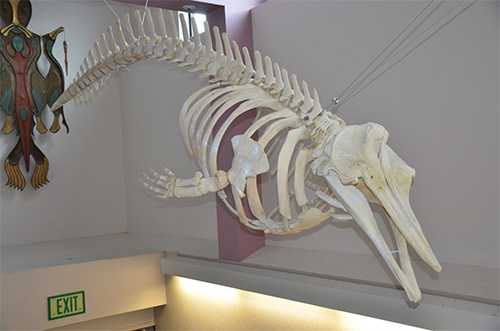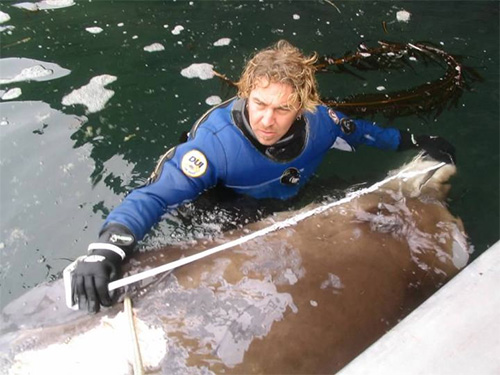
New rare species of whale identified
July 28, 2016
Japanese whalers call the enigmatic black whales "karasu," the Japanese word for raven. The new species is darker in color and about two-thirds the size of the more common Baird's beaked whale, but so scarce that even whalers rarely see them.
The only skeleton of the new species in the United States hangs on display in Unalaska High School, in Alaska's Aleutian Islands. The whale was found dead in 2004, and recent tests on stored tissue samples revealed that it is one of the few known specimens of the new species.
"The challenge in documenting the species was simply locating enough specimens to provide convincing evidence," said Phillip Morin, a research molecular biologist at NOAA Fisheries' Southwest Fisheries Science Center, and lead author of the new study. "Clearly this species is very rare, and reminds us how much we have to learn about the ocean and even some of its largest inhabitants."
In 2004 Reid Brewer of the University of Alaska Southeast measured an unusual beaked whale that turned up dead in Alaska's Aleutian Islands. A tissue sample from the carcass later showed that the whale was one of the newly identified species.
He turned first to the Southwest Fisheries Science Center's marine mammal tissue collection, the largest in the world, and found two samples that appeared to represent a new species. One came from a whale found in Alaska's Aleutian Islands in 2004, whose skeleton now hangs on display at Unalaska High School. Then he and his colleagues pursued additional DNA samples from museums, research institutions and Japanese markets where whale meat is sold. In 2014 scientists found a dead beaked whale on St. George Island, one of the Pribilof Islands in the Bering Sea. When it did not match any known species, they sent samples to Morin. Genetic tests later showed it to be the new species. "We knew it was not any whale we knew from our area," said Michelle Ridgway, a marine ecologist with Oceanus Alaska who documented the whale in the Pribilofs and is a coauthor of the new research. DNA analysis shows that the new species and Baird's beaked whale are each more closely related to Arnoux's beaked whale from the Southern Hemisphere than they are to each other. The genetic differences and smaller size indicate that the black whale is distinctive enough to represent a new species, the scientists found. Official recognition and naming of the species awaits a formal review of the animal's characteristics and differences from other beaked whales. Beaked whales remain among the least known whales in the ocean, with several species identified only in the past few decades. They have beaks like dolphins, diving thousands of feet into deep underwater canyons and basins to feed on squid and bottom fish. Japan hunts Baird's beaked whales, the largest of the beaked whales at about 35 feet long. "Japanese whalers have known about the black form but didn't consider it a separate species," said Erich Hoyt, a research fellow with Whale and Dolphin Conservation in the United Kingdom and co-director of the Russian Cetacean Habitat Project. He is a coauthor of the new research, and his research group contributed genetic samples from beaked whales in the Russian Far East.
Illustration by Uko Gorter of the newly identified species of beaked whale, which is about two-thirds the size and darker in color than the more common Baird's beaked whale.
The eight known examples of the new species cluster around northern Japan and the Aleutian Islands and Bering Sea. That suggests that the species has a smaller range than Baird's beaked whale, which occurs throughout the North Pacific from Japan to Baja California. Scars from the cookie-cutter-like bites of tropical sharks suggest that, like other beaked whales, the species may migrate to tropical waters. "As much as we know about the genetic heritage of this animal, we still do not know very much about the animal itself," Morin said. "We can draw some indications from what we know about other beaked whales in terms of its range and behavior, but we still have many more questions than answers."
On the Web:
Edited by Mary Kauffman, SitNews
Source of News:
To comment, Readers now have the option to provide Comments, Opinions, & Responses on the new easy to use SitNews' auto-post webpage or... Readers may continue to use the FaceBook response section provided below. Representations of fact and opinions in comments posted are solely those of the individual posters and do not represent the opinions of Sitnews.
|
||||



